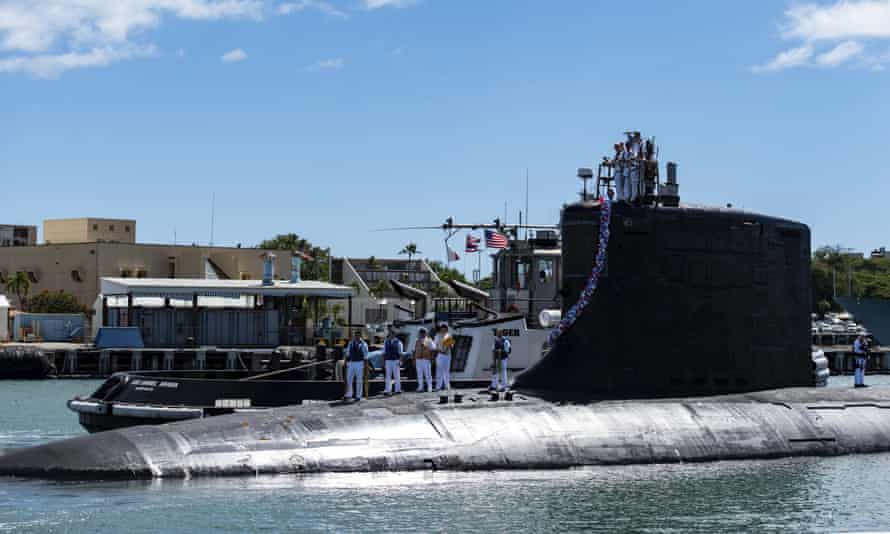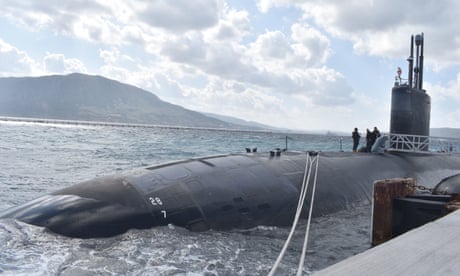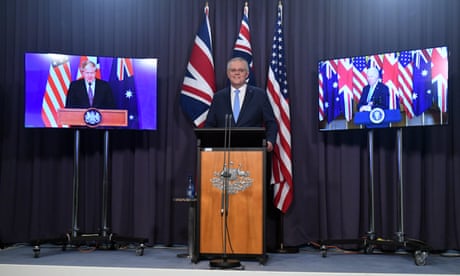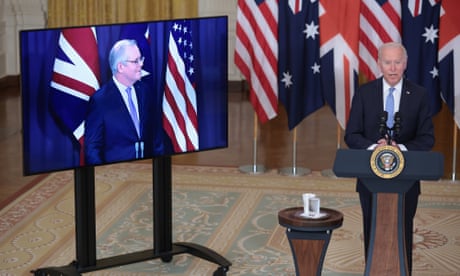Extract from The Guardian
We break down the details and the pros and cons of the technology in the defence deal with the US and UK.

The US Navy’s Virginia-class nuclear-powered submarine USS Illinois. Australia is proposing to obtain variants of the Virginia-class submarine in a deal with the US and UK.
Last modified on Fri 17 Sep 2021 18.39 AEST
The prime minister, Scott Morrison, announced on Thursday morning that Australia would be ripping up its multi-billion dollar contract with the French shipbuilder Naval Group and sign a new deal with the US and UK to acquire nuclear-powered submarines.
The surprise decision announced this morning means Australia will become only the second country (after the UK) to receive the technology from the US.
Naturally, the reaction to Thursday’s news has been divided, and while there are many questions remaining, here is an introductory guide to the basics of nuclear-powered submarines.

What are they and what design might Australia get?
It is not clear which submarine the Australian government will obtain, but the US navy’s latest design is the Virginia-class submarine. Manufactured by American aerospace and defence company General Dynamics, this submarine has gone through several iterations but is generally powered by a single nuclear reactor and can travel at more than 25 knots. Its crew includes 15 officers and 117 enlisted personnel, and the subs are used both in anti-submarine warfare and intelligence gathering operations.
The vessel is powered by a 210MW pressurised water nuclear reactor, inside of which the enriched uranium fuel is sealed. The reactor does not have to be refuelled over its 30-year lifespan.
How do they work?
The submarines are powered by onboard nuclear reactors. These produce energy by splitting atoms to create heat, which is then used to make steam for turbines that generate electricity to power propulsion and its internal systems. To create the steam, the sub draws in seawater and purifies it through a desalination process. Some of this clean water is also used for drinking, the creation of oxygen through hydrolysis and for scrubbing CO2 or other contaminants from the air.
What are the advantages of nuclear?
Diesel-powered submarines, the kind that Australia was initially going to build in partnership with French company Naval Group, tend to be smaller and run more quietly. They can easily slip into shallow waters along coasts or in river estuaries where they are harder to detect.
Nuclear submarines, on the other hand, are built for endurance. With abundant power, some builds can run almost indefinitely, or at least until something breaks down or the crew runs out of tinned food. The only real limitations are the needs of the crew, who can only last so long in a confined space.
What are the drawbacks of nuclear?
Because nuclear submarines tend to be larger, one downside is they can’t move into shallow waters, making them more easily detectable. During one war game in 2015, a Russian-built, Kilo-class diesel-powered submarine used by the Indian navy “sank” a US nuclear-powered sub – although the US navy has never acknowledged the sinking.
Traditionally Australia’s diesel-powered submarines are thought to have been complementary to US powered nuclear subs used by the US, making the recent announcement a surprise.
Nuclear submarines are also more complicated to maintain and service. Unlike the US and UK, Australia does not have a domestic nuclear power industry, which could provide a highly skilled workforce of engineers and nuclear physicists. Much of the work on the subs will probably have to be done overseas.

It is also not clear what plans are being made to handle the spent uranium. The Australian government has been working to build a controversial nuclear waste storage facility in Kimba in South Australia, but this proposal has so far been limited to low-level and intermediate waste from 100 sites around the country.
Are nuclear subs quieter?
It depends. Diesel-electric subs are quieter while running in electric mode, but must at some point surface or pop up a snorkel to run their diesel engines and recharge the batteries. When the diesel engines are running, these noisier than nuclear-powered subs. Nuclear subs also generate noise from the reactor, including the coolant pipes, turbines and steam generation.
What fuel do they use?
HEU is one of the most dangerous metals on earth and also one of the simplest nuclear materials to work with. These twin traits also make it a security risk over fears rogue states or terrorists might develop a nuclear weapon, or mishaps trigger a serious accident. It is also why it has been targeted under non-proliferation treaties to reduce its use.
Will it be able to launch nukes?
If there is one thing the Australian government has been very clear about, it’s that the subs will not be armed with nuclear weapons and that Australia is not seeking to obtain nuclear weapons capability.
That’s not to say the submarine won’t be capable of doing so. Using the Virginia-class as an example, the build comes equipped with 12 vertical missile launch tubes and four 533mm torpedo tubes. It is capable of launching 16 Tomahawk cruise missiles in one salvo but can be modified to mount heavier weapons systems. While these missiles could potentially be built to carry a nuclear warhead, as of 2019 the only variations of the Tomahawk missile in operation were non-nuclear.
What happens when things go wrong?

Serving on a naval submarine has not always been a pleasant experience. For example, German U-boat crews in the second world war suffered devastating losses and many were killed not just in combat but from catastrophic mechanical failures, including asphyxiation from diesel exhaust or explosive decompression after flushing a toilet.
When it comes to nuclear subs, radiation adds a new dimension, although there have been no known reactor meltdowns in the sinkings that have occurred to date.
The most recent nuclear sub disaster involved the Russian Kursk, which sank after a faulty weld on a torpedo caused an explosion that then detonated other torpedos. All of the 118 crew members died. Many were instantly killed in the initial blasts, although failsafes in the nuclear reactor shut it down without incident. The 23 sailors who survived the blasts spent six hours awaiting a rescue that did not come, and were killed in a desperate attempt to create oxygen.
No comments:
Post a Comment